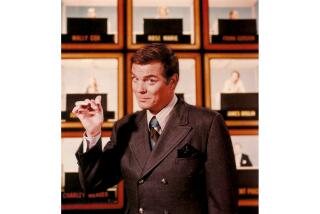Garry Moore; Pioneer in TV Quiz, Variety Shows
- Share via
Garry Moore, the affable, crew-cut host of some of TV’s earliest variety and game shows, died Sunday at his home in Hilton Head Island, S.C. He was 78.
Moore, who to many viewers personified the ingenuousness that emerged from post-World War II America, had been forced by throat cancer and emphysema to leave television in the 1970s.
He recovered from the throat cancer years ago but died of the emphysema, said a son, Garry Morfit Jr.
Moore, in the best show business tradition, had emerged from small-time comedy clubs in Baltimore, St. Louis and Chicago to become a stalwart of radio and then television.
He came to be best known as the longtime host of “The Garry Moore Show,” on both radio and TV and such game shows as “I’ve Got a Secret” and “To Tell the Truth.”
He won an Emmy and a Peabody award but turned down recognition from patriotic and religious groups because he said his work was not that important.
The TV variety show he fronted for 17 years (1950-67) became so successful that other stars, among them Judy Garland, modeled their programs on Moore’s concept of gentle humor, song and whimsy.
Although he had been out of the public eye for years, calling himself “the oldest living thing on public exhibition” because of reruns, for two decades it was difficult to turn on a television set without finding the bow-tie clad comedian on the transmitting side of the tube.
He helped build the treasury at CBS and managed, through shrewd investments and quiet living, to keep much of the salary he had earned.
Moore was a radio veteran who admitted to having little to offer audiences but amiability when he entered TV.
In 1943, he and the beloved comic Jimmy Durante were pushed onto the airwaves to replace Bud Abbott and Lou Costello after Costello fell ill.
The incorrigible Durante, prone to destroying pianos and complaining bitterly over imagined wrongs was a distinctive contrast with the glib but soft-spoken Moore.
Their collaboration marked Moore’s fourth year in radio. He debuted in 1939 as “Thomas Garrison Morfit” on “Club Matinee.”
One of “Club Matinee’s” early broadcasts invited listeners to participate in a “Name the Morfit” contest. One woman won $50 for cutting the last name, eliminating the first and reconstructing “Garrison” to “Garry.”
Moore also had been host of “Beat the Band,” “Breakfast at Sardi’s” and as one of the emcees of “Take It or Leave It,” a quiz program whose $64 question spawned “The $64,000 Question.”
But it was the teaming with Durante that made Moore a national figure.
After years of success on radio, the first “Garry Moore Show,” telecast on June 26, 1950, featured songs, poems, comedy sketches and chats.
Durward Kirby was Moore’s friend and announcer and their relaxed conversations set the pace for the rest of the show.
Carol Burnett was a regular as was a segment of “Candid Camera.”
A mark of the program’s success was that the 1961-62 season produced two Emmys: one for Moore and another for Burnett for an appearance on the program.
He concurrently became the original moderator of “I’ve Got a Secret,” which ran in syndication along with “To Tell the Truth” until the 1970s.
Both programs featured panelists trying to determine what contestants were attempting to hide.
The panelists were stars in their own right: Faye Emerson, Orson Bean, Bill Cullen, Kitty Carlisle, Henry Morgan, Polly Bergen and others.
Unlike the early TV performers who built their shows around their abilities to crack jokes or sing or dance, Moore said his success stemmed from his seeming familiarity.
“I was an everyman,” he said in a 1962 interview. People constantly stopped him thinking that he was a distant relative or a fellow worshiper or a friend of a favorite uncle.
In 1957, he conducted an on-the-air contest, similar to the one that brought him his stage name, in which American men were asked if they thought they resembled Garry Moore.
More than 1,500 snapshots of various crew-cut males were received and 20 were chosen to appear on Moore’s variety show.
In 1976, Moore, former astronaut Buzz Aldrin, actor Dick Van Dyke and then-Rep. Wilbur Mills were among 52 notable figures publicly identifying themselves as recovering alcoholics in a move to gain understanding for the disease.
“This is a great step forward,” Moore said at the time.
Although he was a modest man, Moore could do battle, particularly with advertising agencies who kept trying to increase the number of commercials on his programs.
He appealed to the masses, he said as he neared the end of his career, because he was part of them:
“You should never underestimate the intelligence of the audience but you should never overestimate its knowledge either. Any idea ever conceived by man can be explained to anybody if you don’t insist on being stuffy about it.”
More to Read
The complete guide to home viewing
Get Screen Gab for everything about the TV shows and streaming movies everyone’s talking about.
You may occasionally receive promotional content from the Los Angeles Times.






